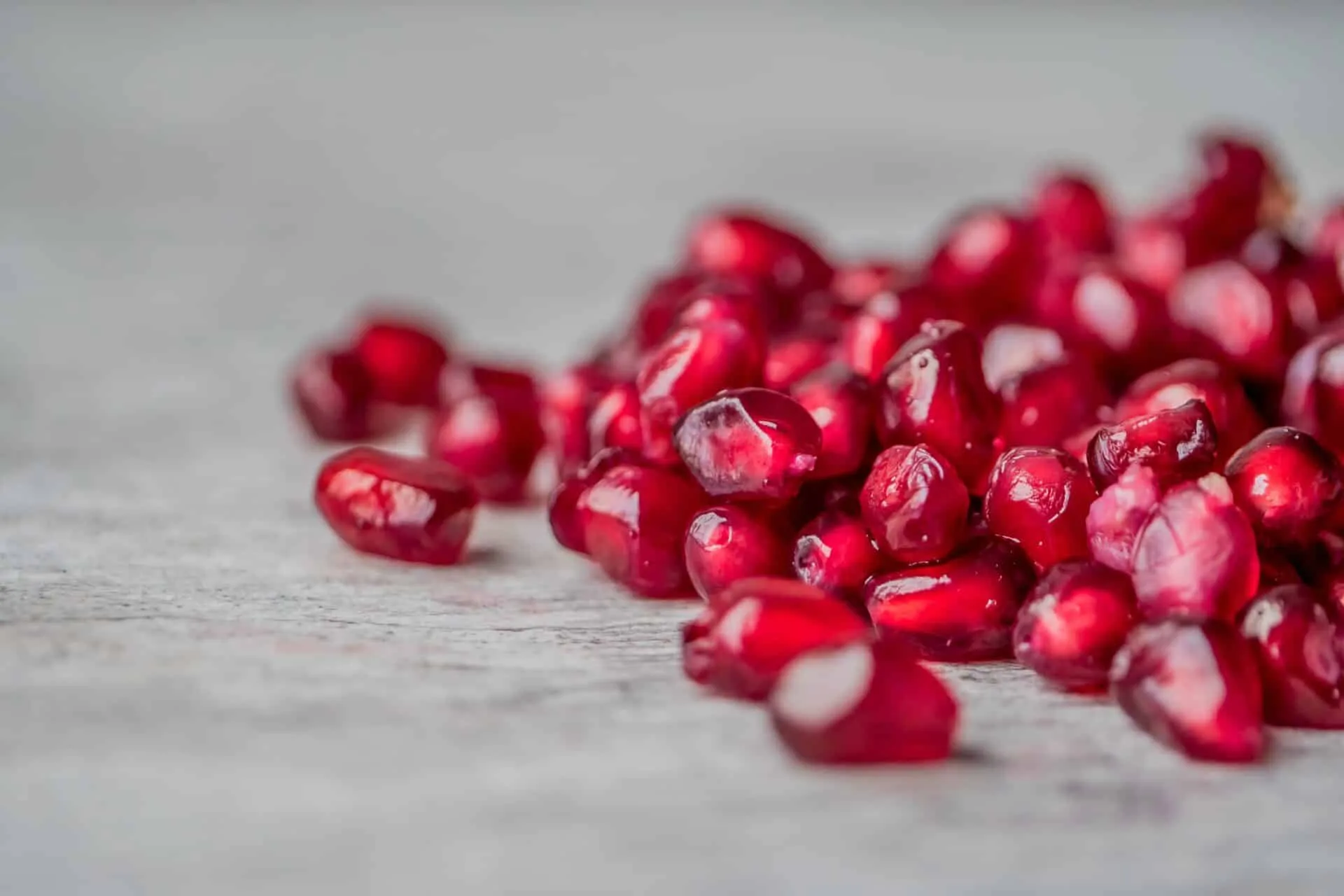The pomegranate is a fruit that has been associated with death since ancient times. Its deep red color and the seeds inside look like drops of blood, which has led to its symbolism of death and mortality. It is believed that pomegranates can ward off evil spirits, and they are often used in rituals to honor the dead. In some cultures, the pomegranate is seen as a symbol of rebirth and renewal, but it is still closely associated with death.Pomegranate has been associated with death for centuries in many cultures throughout history. In ancient Greek and Roman mythology, the pomegranate was seen as a symbol of mortality, being the fruit that Persephone ate in order to be forced to spend half the year in the underworld. In other cultures, it is seen as a reminder of life after death, with its many seeds representing rebirth and resurrection. In Christianity, pomegranates are often used to represent Christ’s passion and suffering for humankind. Additionally, some believe that pomegranates are symbolic of both fertility and death due to their abundance of seeds.
Pomegranate’s Mythological Significance
The pomegranate has long been a symbol of fertility, abundance, and good fortune in many ancient cultures. In Greek mythology, it was believed that the pomegranate was the symbol of Persephone, the goddess of spring. The story goes that Hades tricked Persephone into eating six pomegranate seeds in the underworld, thus binding her to him for six months of each year. This myth came to represent the changing of seasons and renewal each year.
In addition to its connection with Persephone, pomegranates were also sacred to Aphrodite, the goddess of love and beauty. It was believed that by wearing a wreath of pomegranates Aphrodite could attract love and admiration from all around her.
In Judaism, the pomegranate is a symbol representing righteousness and abundance. It is often found on Torah scrolls and tapestries as well as adorning Jewish ceremonial robes. The significance lies in its 613 seeds – one for every commandment in the Torah.
In Islamic culture, it is believed that when Adam and Eve were banished from Paradise they took with them a branch of a pomegranate tree which blossomed in their new home on earth. Pomegranates have also been found depicted on Islamic tiles and ceramics throughout history, further demonstrating its importance to this culture.
The pomegranate has been revered for centuries by many cultures across the world for its symbolic meaning and its nutritional benefits. Whether it be eaten or worn as an adornment, it continues to hold special significance today just as it did in ancient times.
Pomegranate and the Afterlife
Pomegranates have long been associated with the afterlife and death in many cultures. In ancient Greece, pomegranates were used in funerary rites and often placed on graves to honor the dead. In Greek mythology, Hades tricked Persephone into eating some pomegranate seeds while she was in the underworld, which resulted in her being forced to spend part of each year there. This myth is thought to have been the origin of pomegranates being linked to death and the afterlife.
In some Eastern cultures, pomegranates are seen as a symbol of luck and prosperity in life after death. In Hinduism, a pomegranate is considered an offering to deceased ancestors as a way of honoring them and ensuring their safe passage into the afterlife. In Judaism, pomegranates are seen as a sign of fertility, abundance, and immortality because they contain so many seeds. They are also often featured in Jewish weddings as a symbol of new life and everlasting love.
The association between death and pomegranates is not just limited to religious or spiritual beliefs; it can also be found in literature, art, and even modern pop culture. Pomegranates are often used as symbols of mortality or immortality in works of art or literature, such as Dante’s Divine Comedy where he describes them as “the fruit that never dies” or Virgil’s Aeneid where he writes “the unending fruit” when referring to a pomegranate. Pomegranates can also be found in modern pop culture such as Game Of Thrones where they are served at feasts for the dead or Harry Potter where they feature heavily throughout the series both metaphorically (in reference to death) and literally (as food).
Pomegranates have been linked to death and the afterlife for centuries due to their symbolic meanings across various cultures. They are seen not only as symbols of mortality but also fertility, abundance, luck, prosperity, everlasting love, and immortality – all qualities that can be associated with life after death.
Eating Pomegranate and Physical Health
Pomegranates are a nutrient-rich fruit that have been used for centuries to improve health. They are rich in antioxidants, vitamins, and minerals, making them a great addition to any diet. Eating pomegranate can have several positive effects on physical health, including reducing inflammation, preventing the buildup of cholesterol, and reducing the risk of some diseases.
Pomegranate contains punicalagins, which are powerful antioxidants that help reduce inflammation in the body. Inflammation is linked to many chronic diseases such as heart disease and diabetes. By consuming pomegranate regularly, it can help reduce your risk of developing these conditions. Furthermore, pomegranate has been found to be effective at reducing levels of bad cholesterol (LDL) in the blood. This helps prevent heart disease and stroke by preventing fatty deposits from building up in the arteries.
In addition to its anti-inflammatory properties, pomegranate also contains polyphenols which have been shown to reduce the risk of certain cancers such as breast cancer and prostate cancer. Polyphenols are compounds found in many plant foods which can help protect against cell damage caused by free radicals in the body.
Overall, eating pomegranate can have several positive effects on physical health. It is a nutrient-rich fruit that is high in antioxidants, vitamins, minerals, and polyphenols which can help reduce inflammation and protect against chronic diseases such as cancer and heart disease. Pomegranates are an easy way to add more nutrients to your diet while also reaping the health benefits they provide.
Pomegranate As A Symbol Of Death
The pomegranate has been used as a symbol of death in many cultures for centuries. In ancient mythology, it was believed that the fruit could be an offering to the dead and a way to bring them back from the afterlife. In Greek mythology, Persephone is said to have eaten six pomegranate seeds in order to be bound to Hades, the god of the underworld. Similarly, in Christianity, the pomegranate is seen as a symbol of mortality and resurrection, representing Jesus’ death and resurrection.
In Judaism, the pomegranate is also seen as a sign of death and mourning. The Talmud states that when a person dies, their soul departs from them in the form of a pomegranate seed. It is also believed that eating a pomegranate can help heal grief. Additionally, in some Islamic cultures, pomegranates are seen as symbols of fertility and death; they represent both life and death at once.
In some parts of India, it is believed that pomegranates have magical powers which can ward off evil spirits or protect one from harm. Conversely, in parts of Africa they are associated with fertility and immortality; they are seen as symbols of life-giving forces.
Overall, there are many different interpretations of the pomegranate as a symbol of death across various cultures and religions. It is often associated with grief and mourning but it can also represent fertility or be seen as an offering to appease deities or ward off evil spirits.

Pomegranate in Religions Around the World
The pomegranate has long been a symbol of abundance, fertility, and prosperity in many religions around the world. In Christianity, the pomegranate is believed to represent the resurrection of Jesus Christ and his eternal life. In Judaism, it is seen as a symbol of righteousness and abundance and is often used in religious ceremonies. In Islam, the pomegranate is believed to be a sign of piety and faithfulness. It is also seen as a symbol of prosperity and abundance in Hinduism.
In many cultures, the pomegranate is seen as a sacred fruit that can bring good luck and ward off evil spirits. The Chinese believe that eating a pomegranate brings good fortune and longevity. In Ancient Greece, it was thought that eating a pomegranate could prevent sickness and bring good health.
In some cultures, the pomegranate is seen as an important part of mythology. In Greek mythology, for example, Persephone was tricked into eating six pomegranates seeds while in the underworld with Hades, which resulted in her having to stay six months out of each year with him.
The pomegranate has also been used to decorate religious objects such as altars or temples throughout history. Its vibrant color has made it an attractive choice for artisans who have incorporated it into their work. In India, for example, ornamental designs featuring the fruit are often used to adorn shrines dedicated to various gods and goddesses.
In many religions around the world, the symbolism associated with the pomegranate often reflects its role as a source of nourishment and sustenance for humans and other creatures alike. For this reason, it can be found featured prominently in religious ceremonies across various cultures where it serves both spiritual and practical purposes alike.
Pomegranates and Funeral Practices
Pomegranates have long been seen as a symbol of fertility, abundance and life in many cultures and traditions. As such, they have been used in traditional funeral practices for centuries. In some cultures, the pomegranate is seen as a symbol of rebirth and eternity, while in others it is used to honor the deceased. One of the most common funeral practices that involves pomegranates is the display or scattering of pomegranate seeds around the coffin or grave site of the deceased. This is done as a way to honor and remember the person who has passed away, as well as to signify their eternal life.
In some cultures, pomegranates are also used in rituals or ceremonies that mark death or mourning. For example, in some Middle Eastern cultures, it is common to place a pomegranate on top of the coffin during burial ceremonies. This symbolizes fertility and abundance for the deceased’s journey into eternity. In other cultures, it is customary to offer pomegranates to visitors who come to mourn with family members after a death. This gesture serves as an acknowledgement that even in death there can be hope for new life.
In addition to being used in funeral practices, pomegranates are also often included in memorial services or ceremonies that are held after someone passes away. Pomegranate symbols may be placed on altars or at gravesites as offerings to honor the dead. They may also be placed on wreaths or bouquets that family members bring to memorial services or funerals for their loved one. Pomegranate symbols also often appear on tombstones, which serve as an eternal reminder of someone who has passed away and can bring comfort to those mourning their loss.
Pomegranates have long been used in traditional funeral practices for their symbolic meaning and cultural significance. From scattering pomegranate seeds around gravesites to placing them on altars during memorial services, these fruit have become an important part of honoring those we love when they pass away.
Pomegranate and Grief Rituals
Pomegranate is often associated with grief and mourning rituals in many cultures. In the Jewish tradition, pomegranate has a special significance in mourning rituals. It is believed that the seeds of a pomegranate symbolize tears that have been shed during grief and mourning. In some cultures, it is customary to place a pomegranate on the grave of a deceased person to honor their memory. In other cultures, pomegranates are used to decorate memorials or shrines built for the deceased.
In some parts of Asia, including India and Nepal, it is customary to offer a pomegranate as part of funeral rites. It is believed that this gesture will bring good luck to the deceased person’s soul and provide them with a safe journey into the afterlife. Pomegranates are also offered as gifts during Hindu festivals such as Diwali and Holi, when people remember their deceased ancestors or loved ones.
In Islamic culture, pomegranates are believed to be sacred and are often used in mourning rituals. It is believed that when someone passes away, their soul will be comforted by eating pomegranates in the afterlife. Pomegranates are also often placed on graves or tombs as an offering to the deceased person’s spirit.
Pomegranates have long been associated with grief and mourning rituals in many cultures around the world. They are seen as symbols of hope, comfort, and remembrance for those who have passed away. Whether it’s placing them on graves or offering them as gifts during festivals, pomegranates can be an important part of honoring those who have passed away and showing respect for their memory.

Conclusion
The pomegranate has been a symbol of death and the afterlife for centuries. Its rich, deep color and mysterious shape have been associated with death in many cultures and religions. From ancient Greece to modern-day Christianity, the pomegranate has served a variety of symbolic roles. It has been used as an offering to the gods, a symbol of fertility, and even a representation of life after death. No matter how it is interpreted, the pomegranate is undoubtedly connected to death in some way or another.
The pomegranate’s connection to death makes it a powerful symbol in modern culture. It is an icon that can be used to remember those we have lost and remind us that life must go on. The pomegranate will always be associated with death, but this is not necessarily a bad thing. We can use its symbolism to help us remember our pasts and move forward into our futures with hope and strength.



